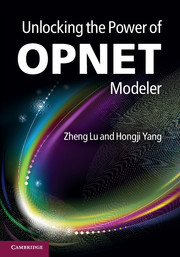Book contents
- Frontmatter
- Contents
- Preface
- List of abbreviations
- Part I Preparation for OPNET Modeling
- Part II Modeling Custom Networks and Protocols
- Part III Modeling and Modifying Standard Networks and Protocols
- 8 Modeling wired networks with standard models
- 9 Modeling wireless networks with standard models
- 10 Modifying standard models
- Part IV OPNET Modeling Facilities
- References
- Index
9 - Modeling wireless networks with standard models
from Part III - Modeling and Modifying Standard Networks and Protocols
Published online by Cambridge University Press: 05 February 2012
- Frontmatter
- Contents
- Preface
- List of abbreviations
- Part I Preparation for OPNET Modeling
- Part II Modeling Custom Networks and Protocols
- Part III Modeling and Modifying Standard Networks and Protocols
- 8 Modeling wired networks with standard models
- 9 Modeling wireless networks with standard models
- 10 Modifying standard models
- Part IV OPNET Modeling Facilities
- References
- Index
Summary
This chapter explains the concepts and techniques of building wireless networks based on standard OPNET models. It is essential to understand the concepts described in Chapter 8 when reading this chapter, and a basic knowledge of wireless technology is required.
Basics of wireless modeling
The processes for modeling wireless networks are similar to those for modeling wired networks in OPNET Modeler. However, there are some differences. For wireless networks, nodes are connected via invisible radio links instead of cable links. Unlike fixed cable links, a radio link can be influenced by interference, antenna pattern, and movement of mobile nodes. Therefore, it requires simulation to dynamically compute radio link connectivity, propagation delay, and power levels.
In Node Editor, there are three modules used for modeling wireless nodes: Radio transmitter, Radio receiver and Antenna, as shown in Figure 9.1.
In Figure 9.1, the module marked no. 1 is the radio receiver module, the module marked no. 2 is the radio transmitter module, and the module marked no. 3 is the antenna module. Radio transceiver modules allow packets to be sent or received via radio links. The antenna module can be used to exchange packets with other nodes when antenna directionality or gain needs to be modeled. Antenna module is associated with Radio transmitter and Receiver modules by means of packet streams as shown in Figure 9.1. Antenna location in three-dimensional space can be determined by Antenna module's “latitude”, “longitude”, and “altitude” attributes.
- Type
- Chapter
- Information
- Unlocking the Power of OPNET Modeler , pp. 137 - 150Publisher: Cambridge University PressPrint publication year: 2012



